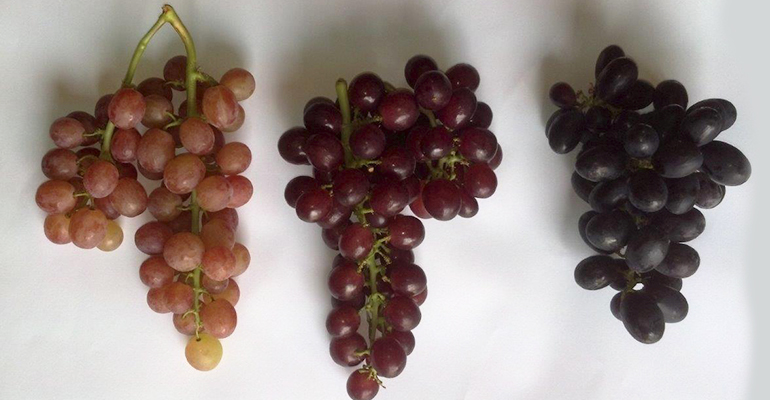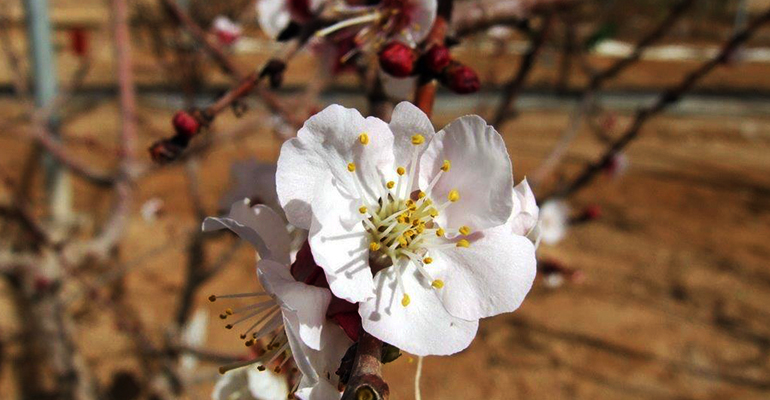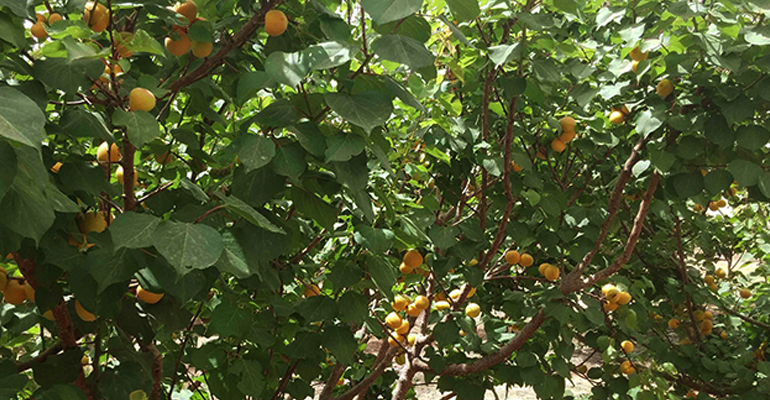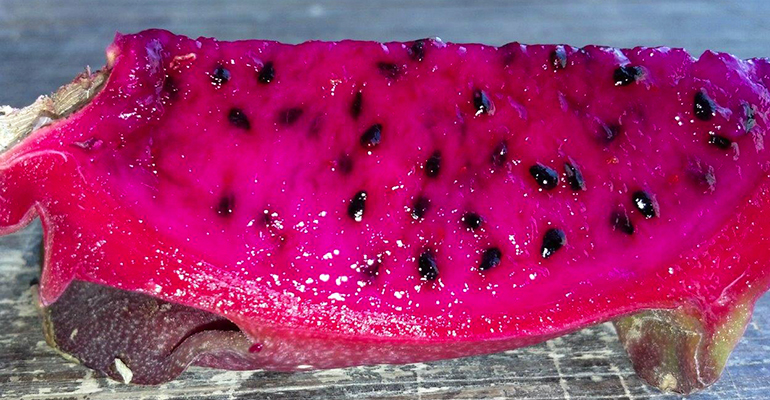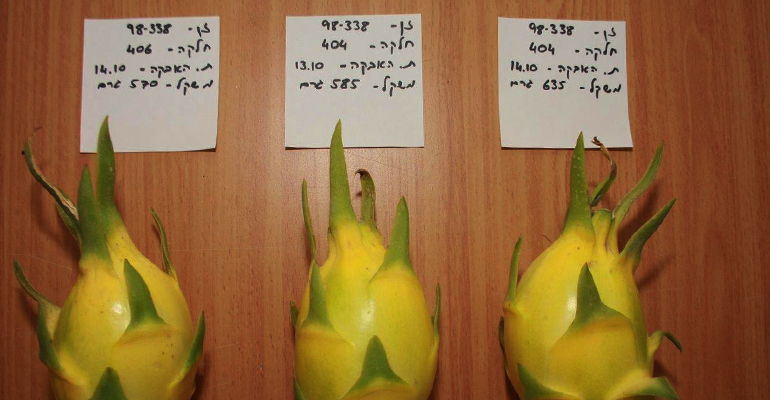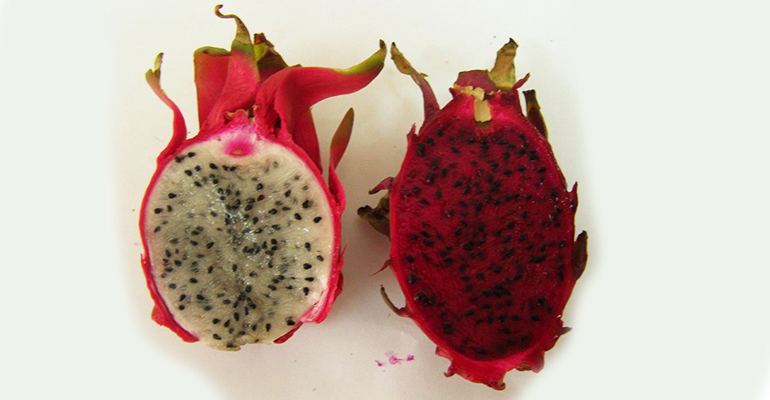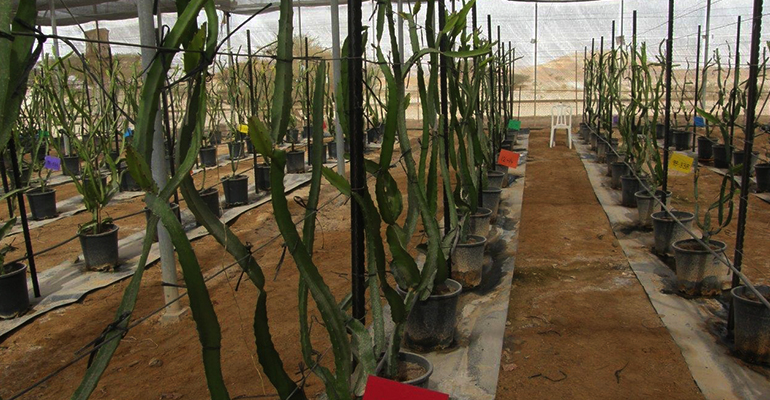Orchard
Plantations in the Central and Northern Arava include mainly dates, vineyard grapes and mango. In addition, there are a few plantations of papaya, guava, argania (Argania spinosa) and moringa. The main species in the commercial cultivation is the date palm growing in common plots, alongside private plots planted by farmers.
R&D studies focus on optimizing the use of water in various qualities, improving agro-technics, plant protection practices and introduction of new crops.
Studies are conducted at three locations: Zohar station, Yair station and Moshav Paran with vineyard grapes and deciduous orchard, peaches, nectarines and apricots.
Dates
Research is conducted on the following topics:
Examining the effect of reduced amount of water on Medjool dates cultivar throughout the year and prior to harvest.
Yield load control by fruit dilution.
Plant Protection: control of greater date moth and neck rot disease of date palm.
Vine
Improving agro-technics and varieties at Yair Experimental Station.
Introduction of new crops and varieties
Various crops like mango, apricot, pitaya, peaches, nectarines and apricots, are being examined as part of the search for alternative crops for the Arava region. The new alternatives are subject to the constraints of economic viability, reducing expenses and inputs, mainly labor.
Experimental plantations of desalinated water, Sodom Valley
Mango and vine are tested at the Zohar Experimental Station, using desalinated water. Early varieties are being studied for their adaptability to the local conditions.
Management
Recent Reports
-
13yearsago
Development of a system and machinery for collection and removal of crop residue from protected plots
Orchard, Vegetablesby Yossi Kashti11
תחום או ענף אגרוטכנולוגיה; אורגני; ירקותתאריך עדכון 14/3/2012
Development of a system and machinery for collection and removal of crop residue from protected plots
Y. Kashti, I. Sagi, O. Kesar, A. Levi, F. Geoola, R. Brikman – Institute of Agricultural Engineering, ARO
A. Gadiel – Central and Northern Arava R&D
R. Amir – Extension Service, Ministry of Agriculture and Rural Development
E-mail address for correspondence: ykashti@volcani.agri.gov.ilAbstract
At the end of a season of vegetable production in a greenhouse, the plants are manually removed. This process requires 3 work days and 5 tractor hours per dunam. The material is removed for sanitary reasons, to avoid the transmission of diseases to future crops. The amount of greenhouse vegetable production in Israel stands at 65,000 dunams. Thousands of work-days are spent removing the remains of old crops from these areas.
The goal of this research is the development of a method and equipment for the mechanization of this process. Examination of the matter led to the identification of three possible methods for mechanized removal of crop residue. We chose to more closely examine the cheapest of these methods. The chosen method includes three mechanized activities that are carried out one after the other with the help of the farm tractor. The activities are: uprooting the plants, concentration of the uprooted plant material in a bin and collecting and chopping up the plants as they are collected as preparation for the production of compost. Over the last two years, we examined the process of removing crop residue from greenhouses with the help of different types of existing equipment, machines that were specially prepared and tested and machines that were purchased from different manufacturers. We tested the abilities of four types of uprooting machinery to uproot whole plants and crop residue: a knife uprooter with one central leg, a knife uprooter with two side legs, a disc uprooter and a finger uprooter. A piece of equipment based on a set of pitchforks was evaluated in an area thick with whole plants and residue. We evaluated the efficacy of two types of mowers for collecting and chopping up whole plants.
The mechanized residue removal experiments were conducted in the western Negev and the central Arava. The experiments were conducted in pepper plots in screen-houses and greenhouses belonging to different developers, on sandy and sandy/loess soils, with varying agro-technical specifications (plot width, number of rows per plot, distance between rows, etc.) The main experiments were conducted in the Arava beginning in early May, immediately after the last harvest while the plants were still green and continued each month until the plants withered.
After two years of research, the results of this work show that the optimal timing for removing crop residue is immediately after the last harvest while the plants are still green. At that point, few leaves and fruit are cut-off from the plants and dropped to the ground. We also found that collecting plant matter and then depositing it in place with a mower that includes a container and has no pick-up (wheel with lifting fingers) left the area cleaner. The finger plow successfully uprooted crop remains in moist and dry soil.
Based on the results obtained from two seasons of research (2009/10 and 2010/11), it appears that the possible process for mechanized removal of crop residue includes two phases: 1) mowing with a mower that includes a container immediately after the last harvest, while the plants are still standing in the ground; and 2) uprooting and collecting the crop residue. Therefore, before the third year of this research, we will build a mower without pick-up that has a large container that will be sufficient for the collection of plants from at least two plots and the collection of the crop residue after uprooting.Acknowledgements
We thank the growers, Noa and Atar Sahak from Hetzva and the staff and management of the Besor Farm and the Yair Farm, on whose property experiments were carried out, for their help. We thank Amotz from the Ego Company and Aharon Yemini for contributing the piece of equipment based on a set of pitchforks and the mower for the first experiments. We thank Motti Ben-Ami from the Ein Yahav welding shop for helping us with tool repair. Special thanks to Ram Golan, on whose farm the main experiments were carried out, for dedicating his time and effort to this project and for very pleasantly providing us with advice and technical equipment. Thank you to Mickey Kaplan, Central and Northern Arava R&D Tamar, as well as the office of the Chief Scientist of the Ministry of Agriculture for financial support for research project no. 458-0518-09.שפה English
מלות מפתח vegetable, greenhouses, pepper, capsicum
מחבר Yossi Kashti, I. Sagi, O. Kesar, A. Levi, F. Geoola, R. Brikman, A. Gadiel, R. Amir
שנה 2011
שייכות yzvieli
תאריך יצירה 14/3/2012
תאריך עדכון 14/3/2012 -
13yearsago
Irrigation of a mango plantation with desalinated water, Sodom Valley
Orchardby Dafna Harari7
תחום או ענף מטעים
תאריך עדכון 14/3/2012Irrigation of a mango plantation with desalinated water, Sodom Valley
Dafna Harari, Ami Maduel, Uri Zeiri, Aviran Asraf, Rami Golan, Svetlana Gogio – Central and Northern R&D Arava
Baruch Luzon, Izik Kosto, Shlomo Kramer – Extension Service, Ministry of Agriculture and Rural Development
E-mail address for correspondence: dafnahr@arava.co.ilAbstract
Aside from dates, no orchard or vineyard crops have been grown in the Sodom Valley area, unlike the southern areas of the Arava Valley, in which mango and grapes are grown. Despite the unique climate of the Sodom Valley area and the early-ripening advantages associated with such a climate, the area in this region planted to orchards/vineyards (excluding dates) is limited and includes small areas of Brazilian figs and papaya. The main reason for this is the quality of the water. The saline water available in the area has an EC of 3.5-4. In the case of perennial crops, such as orchard crops and grapevine, the salt accumulates in the plant, there is a subsequent decrease in growth and yield and the trees or vines eventually die. In the past, experiments were conducted involving orchard crops and vineyards in the region, but these efforts did not succeed over the long term due to the accumulation of salts. The decrease in the cost of desalinated water and the development of more effective, cheaper technologies have made possible the desalination of water for agriculture. This desalinated water can be blended with local water. The quality of this blended water is just as good as that of the piped water in the northern and central parts of the country. That is, this water has a salinity level of 1-1.5 (dS/m).
In 2006, a mango orchard was planted on the grounds of the Zohar Experimental Station. Mango cultivars Shelly and Tommy were planted in a screen-house. Some plots were irrigated with the local piped water and the others were irrigated with desalinated water. The plots were separated by sheets of polyethylene that extended to a depth of 1.5 m, in order to prevent the roots from growing in the direction of the blended water. After six growing seasons, large differences were noted in the growth of the plants and the quantity and quality of their yields. Soil and root examinations in the treatment that was irrigated with local pipeline water revealed increased salinity in the deeper layers and, for that reason, fewer roots. The damage that the salinity caused the trees was visible in both cultivars, but was especially notable in cv. Shelly; some of those trees dried up completely. Regarding the yield, we saw heavy fruit production throughout the orchard, in both cultivars and both irrigation treatments. The cv. Tommy did comparatively better when it was irrigated with the blended water. In cv. Shelly, there was no significant difference in export-quality yield, but about 30% of the yield of this cultivar was made up of small fruit (less than 200 g) that were not fit for export. In light of the results of this study, it is clear that the expansion of the variety of orchard crops grown in Sodom Valley requires a supply of water that is significantly less saline than that currently available for agriculture. The success of the experiment will open up new ways to take advantage of the idea of building a central desalination facility for each region.שפה English
KETWORDS irrigation, salinity
AUTHORS Dafna Harari, Ami Maduel, Uri Zeiri, Aviran Asraf, Rami Golan, Svetlana Gogio, Baruch Luzon, Izik Kosto, Shlomo Kramer
שנה 2011
שייכות yzvieli
תאריך יצירה 14/3/2012
תאריך עדכון 14/3/2012 -
14yearsago
AGROTECHNIQUES FOR PRODUCTION OF TABLE GRAPES IN AN ORGANIC VINEYARD
Orchardby Dafna Harariתחום או ענף מטעים
תאריך עדכון 9/4/2010תיאור מלא Dafna Harari and Omer Galor – Central and Northern Arava R&D
Baruch Luzon – Negev Region, Extension Service, Ministry of Agriculture
Eyal Raban – Orchard Department, Extension Service, Ministry of Agriculture
Etty Or – Orchard Department, Volcani Center, AROAbstract
In the Arava, there is little use of pesticides for the control of pests and diseases. This fact makes it possible to evaluate the organic production of table grapes. Together with the increasing public awareness of the issue of pesticide residues, the Yair Research Station was allocated an organic vineyard. In 2007, there was a severe outbreak of powdery mildew in this vineyard and none of the produce from that year could be marketed. In 2008-2009, we tested a treatment program for the control of powdery mildew that was appropriate for an organic vineyard. This program was based on a preliminary treatment following pruning to ensure early and uniform emergence from dormancy, as well as the use of polyethylene sheets on the rows of the vineyard. The pruned vines in the plots that had been covered with polyethylene sheets emerged from dormancy earlier and in a more uniform fashion than the vines in the uncovered plots. The grape yield was relatively high as compared to that observed in a conventional vineyard of cv. SBS (‘Early Sweet’), approximately 3 tons/dunam of high quality grapes and an additional 0.75 tons/dunam of lower quality grapes. Research efforts toward a preventative treatment for powdery mildew should be continued.Email address of the writrer: dafnahr@arava.co.il
שפה English
מחבר Dafna Harari, Omer Galor, Baruch Luzon, Eyal Raban, Etty Or
שנה 2010
שייכות yzvieli
תאריך יצירה 10/4/2010
תאריך עדכון 10/4/2010


